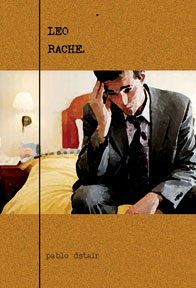Minimalism and beyond: A discussion on two postmodern works of
American fiction
By Dilshan BOANGE
(Part 2)
Leo Rache
Continuing from part one of this article, which looked at the
strangeness of the unnamed faceless speaker of "Hand to Bone", the focus
now moves to the story of an impulsive, bohemian self indulgent poet
-"Leo Rache" by Pablo D'Stair. The protagonist is Leo, about whom the
story provides a 'slice of life' through a third person narrative with
the postmodernist stylistic technique of minimalism being one of the
salient features. Like in "Hand to Bone" the absence of similes and
overtly detectable metaphors to conjure imagery is notable in Pablo's
work of fiction.
 |
|
Pablo D'Stair |
 |
|
Leo Rache |
Leo has a free spirited highly impulsive drive in him
and depicts an existential disposition. He has a penchant for petty
theft, to be specific -notebooks, which he shoplifts on numerous
instances. Although a young man who has meager means of income he does
not thieve notebooks (in which he writes his poetry) for lack of money
to pay for them. In fact once when caught he agrees to pay double for
the goods to avoid being handed over to the police. Rather it seems that
Leo steals out of impulse (possibly a mark of a kleptomaniac) and the
sense of adventure it gives in that spur of the moment. So therefore he
doesn't come out as a poetic Jean Valjean (protagonist of Victor Hugo's
"Les Miserables") trying to feed his creative longings.
An existential attitude
The style adopted by Pablo is like reportage. The lack of adjectives
and ornamental descriptivism presents a very fact-like-narrative of the
character, primarily from a point of his actions, traversing, and also
phenomena and events he encounters. One of the demonstrations of Leo's
impulsiveness comes out in a scene where he throws over the bridge to
the river beneath a book of Wallace Steven's poetry lent him by his flat
mate Blake.
The reason being simply that he didn't like the book. And it is only
after the impulsive act has been performed that he wonders what he would
say to Blake to explain the missing book. This lack of regard for
consequences and acting out the impulse resonates very strongly with
existential philosophy, which is exemplified in Albert Camus's "The
Outsider". The idiosyncrasies of Leo show him in a way as somewhat of an
'outsider' in the larger context of society and its norms.
The significant 'woman' factor
A turning point in the character of Leo seems to be where the
character of Anna comes in to the narrative. Anna who is a single mother
appears to be very much an alluring figure of womanliness to the much
younger Leo who is attracted to her powerfully and in fact finds her
sense of womanhood to be more desirable than girls who are his peers
with whom he has had romantic involvements.
From a point of bodily comparatives, Leo decides that the very
physique of one such as Anna offers certain 'developedness' over the
underdeveloped prospects of Vera, a girl who is attracted to Leo's
personality as a self styled poet. The amorously physical relations he
develops with Anna causes a significant turning point that develops an
inspiration in Leo that leads to what is arguably the apex of the
story's symbolisms.
The poetic of the female physique
In the aftermath of having sexual relations with Anna, Leo embarks on
a journey to meet a female character named Lea who is referred to in the
narrative as someone who is supportive of Leo's efforts in poetry
writing, and holds an endeared place in his thoughts. Leo sends Lea
poetry he writes for her critical reception and thus has a metaphysical
bond with her, though she enters the story only at the very last stage.
Lea is presented as a distant persona that serves Leo's inspirations by
encouraging him in his aspirations. And the purpose of the visit to Lea
who lives considerably far from where Leo is, so that he may realize
another of his 'impulse drive' inspired thoughts -to write on her body.
The story ends with Leo performing this poetic act where Lea's entire
body is covered with his writings which she admires in a mirror and asks
him to copy it out for her on paper which he willingly does and then Lea
washes off the ink (writings) on her body and leaves the hotel room they
occupy for this artistic endevour. The final part of the story is
produced as follows -"I feel like a bruise all over, she said, touching
where he'd just dried. Her phone rang. She looked at the number, let it
ring, said she really needed to go, there was some mandatory thing for
her job. He smoked three cigarettes, naked, looking at the closed door,
finished the wine except what she'd left in her glass." (p.57-58).
The artistic apex and its symbolisms
The writing on Lea's body seems like an artistic culmination where
Leo as the creator (artist/poet) crafts a moment of oneness of his
work/creation and his muse -Lea. The body of Lea (and she herself) could
be an apex symbolic of the artist realizing his moment of artistic
vision in tangible form. It could seem that Leo's psychology drove him
to seek unification between him, his muse, and the creative outpourings
he develops as his artistic visions, to take form as a living work,
which holistically encapsulates his being as a man whose life is the art
of his poetry. The process that Pablo narrates to the reader where Leo's
writings pour out on to the paper (like a canvas) that is Lea's skin
(body) shows a symbolic value of how that moment marked a poetic ecstasy
in the 'creation process' which perhaps brought cohesion and meaning to
Leo's emptiness of a scattered bohemian life. It is very much an
instance of 'living a dream', an arty fantasy as the creator became one
with his creation. I say this because Leo as an artist would be (at that
moment) 'living in' the creation that takes form which is physically on
(the skin of) the muse who inspired his inner poetic being, and this
muse would also thereby hold a metaphysical aspect of him.
"Will to power"
Pablo's work comes out as a powerful portrayal of the obdurate
bohemian individual whose artistry drives forth his will to exist and
perpetuate his vision (work) on another and resonates with the famous
belief of German philosopher Friedrich Nietzsche -'Will to power'. The
power that Leo subconsciously seeks to perpetuate seems to be artistic
visions of a self indulgent poet who may cause unintended tyranny in the
coursing of his trajectory as an artist. And the indulgence in his own
artistry may evoke another idea of Nietzsche which Michael Ondaatje
speaks of in his latest novel "Divisadero" -"We have art so that we will
not be destroyed y the truth." It is this escape from oppressive 'truths
of the world' that marks Leo as a highly individualistically envisioned
person in terms of his art.
That may well be the reason that Pablo does not provide the reader
one single line of what Leo writes. However from the point of the reader
there could be a strong desire to know what exactly Leo may have written
on the body of Lea to develop a fuller picture of that scene. But then
again the minimalism of the novel probably would not allow such
elements. It is for the reader to bring his active role in to the
reading, to develop the image of that moment which the author has
presented with the postmodernist approach of minimalism.
Notions of identity
The idea of subjectivity rides very high in the narrative which
depicts the outlooks of Leo and the matter of identity which is not
really presented as a dilemma in the traditional sense. And unlike the
modernist approach Pablo does not present a character who seeks
'answers', 'solutions' to the existential dilemma which is somewhat
underscored in the text as opposed to being the overt thematic
definitive. Instead he 'plays in it', developing a portrait of an
individual not from the institutionally orthodox grounding on identity
as the details on an ID card. No, it is the vision and actions of the
character that draws a portrayal of his identity, rather than answering
question such -where is he from? What did his parents do? Is he a church
goer?
The fact that Leo sits in a hotel room naked smoking cigarettes at
the closing of the story does not tell the reader what 'the rest of
Leo's life is going to be like', is part of the very idea of presenting
a selected facet of the character's life, the 'slice of life' that
presents 'a facet' of his being and psychology rather than the socially
constructed life and definition of a person. And so the text leaves the
reader in "Leo Rache" where the protagonist, a self made poet, realizes
his artistic meridian existing in a moment just after the 'poetic
process' that manifested his visions to make his 'life into art' and
vice versa.
Both the discussed novels "Leo Rache" and "Hand to Bone" present a
strong ground to explore the postmodern questions of identity through
highly subjective character perpectives and have stylized the narratives
through minimalism. And both these works can be seen as dealing with the
postmodern focus of 'the individual' in the face of society, which is
very much one of the thematic foci in postmodernist literature as said
by novelist Ian McEwan who says, of his perspective of what post
modernist literature looks at and presents -"The representation of
states of mind and the society that forms them".
|

